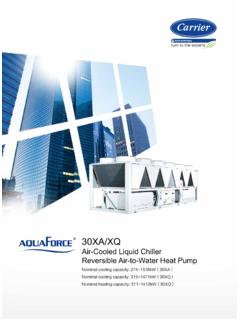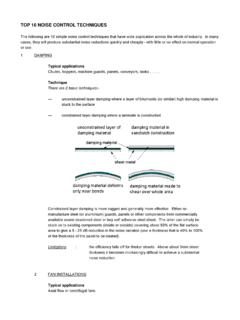Transcription of 'Design of Active Noise Control Systems With the …
1 Design of Active Noise Control Systems with the TMS320. Family Application Report 1996 Digital Signal Processing Solutions Printed in , June 1996 SPRA042. If the spine is too narrow to print this text on, reduce ALL spine copy (including TI bug at the top of the spine and the year at the bottom) the same amount and re- position at the reference marks as shown for the blue- line. If the reduction required is such that the resulting copy is very small, we may opt to print the spine with no text. Design of Active Noise Control Systems with the TMS320 Family Sen M. Kuo, Issa Panahi, Kai M. Chung Tom Horner Mark Nadeski Jason Chyan Digital Signal Processing Products Semiconductor Group SPRA042. June 1996. Printed on Recycled Paper IMPORTANT NOTICE. Texas Instruments (TI) reserves the right to make changes to its products or to discontinue any semiconductor product or service without notice, and advises its customers to obtain the latest version of relevant information to verify, before placing orders, that the information being relied on is current.
2 TI warrants performance of its semiconductor products and related software to the specifications applicable at the time of sale in accordance with TI's standard warranty. Testing and other quality Control techniques are utilized to the extent TI deems necessary to support this warranty. Specific testing of all parameters of each device is not necessarily performed, except those mandated by government requirements. Certain applications using semiconductor products may involve potential risks of death, personal injury, or severe property or environmental damage ( Critical Applications ). TI SEMICONDUCTOR PRODUCTS ARE NOT DESIGNED, INTENDED, AUTHORIZED, OR. WARRANTED TO BE SUITABLE FOR USE IN LIFE-SUPPORT APPLICATIONS, DEVICES. OR Systems OR OTHER CRITICAL APPLICATIONS. Inclusion of TI products in such applications is understood to be fully at the risk of the customer.
3 Use of TI products in such applications requires the written approval of an appropriate TI officer. Questions concerning potential risk applications should be directed to TI through a local SC. sales office. In order to minimize risks associated with the customer's applications, adequate design and operating safeguards should be provided by the customer to minimize inherent or procedural hazards. TI assumes no liability for applications assistance, customer product design, software performance, or infringement of patents or services described herein. Nor does TI warrant or represent that any license, either express or implied, is granted under any patent right, copyright, mask work right, or other intellectual property right of TI covering or relating to any combination, machine, or process in which such semiconductor products or services might be or are used.
4 Copyright 1996, Texas Instruments Incorporated Content Title Page ABSTRACT .. 1. INTRODUCTION .. 3. The General Concept of Acoustic Noise Control .. 3. General Applications of Active Noise Control .. 4. The Development of Active Techniques for Acoustic Noise Control .. 5. EVALUATING THE PERFORMANCE OF ANC Systems .. 7. TYPES OF ANC Systems .. 9. The Broadband Feedforward system .. 9. The Narrowband Feedforward system .. 10. The Feedback ANC system .. 11. The Multiple-Channel ANC system .. 12. ALGORITHMS FOR ANC Systems .. 13. Algorithms for Broadband Feedforward ANC Systems .. 13. Secondary-Path Effects .. 14. Filtered-X Least-Mean-Square (FXLMS) Algorithm .. 15. Leaky FXLMS Algorithm .. 20. Acoustic Feedback Effects and Solutions (FBFXLMS Algorithm) .. 20. Filtered-U Recursive LMS (RLMS) Algorithm .. 24. Algorithms for Narrowband Feedforward ANC Systems .
5 27. Waveform Synthesis Method of Synthesizing the Reference Signal (Essex Algorithm) .. 27. Adaptive Notch Filters .. 31. Algorithms for Feedback ANC Systems .. 35. DESIGN OF ANC Systems .. 39. system Considerations .. 39. Sampling Rate and Filter Length .. 40. Coherence Function .. 41. Causality .. 42. Constraints and Solutions .. 43. Automatic Gain Controller .. 44. Antialiasing and Reconstruction Analog Filters .. 45. Analog Interface .. 46. ANC system SOFTWARE .. 47. Implementation Considerations .. 47. Quantization Effects in Digital Adaptive Filters .. 47. Real-Time Software Implementation Process .. 50. Implementation of Adaptive Filters with the TMS320C25 .. 51. Using the TMS320C2x Simulator to Observe Noise Cancellation .. 55. Understanding How Individual Parameters Affect Algorithm Performance .. 56. iii PHYSICAL SETUP OF EXPERIMENTAL ANC system IN AN ACOUSTIC DUCT.
6 59. OPTIMIZATION OF THE EXPERIMENTAL system .. 61. Determining the Value of .. 61. Determining the Value of LEAKY .. 63. Determining the Gain of the Preamplifier .. 64. Single-Tone Sinusoidal Noise Source Case .. 66. Multiple-Tone Sinusoidal Noise Source Case .. 69. CONCLUSION .. 75. REFERENCES .. 77. Appendixes Title Page APPENDIX A: PSEUDO RANDOM NUMBER GENERATOR .. 81. APPENDIX B: DIGITAL SINE-WAVE GENERATOR .. 83. Table Look-Up Method .. 83. Digital Oscillator .. 84. APPENDIX C: TMS320C25 ARIEL BOARD IMPLEMENTATION OF. ANC ALGORITHMS .. 85. The Filtered-X LMS Algorithm .. 85. Filtered-U RLMS Algorithm .. 95. Filtered-X LMS Algorithm with Feedback Cancellation .. 107. APPENDIX D: GENERAL CONFIGURABLE SOFTWARE FOR ANC EVALUATION .. 121. Configuration File ( ) Description .. 122. ANC Algorithm Module Listing ( ) .. 127. ANC Linker Command File ( ).
7 138. ANC system Configuration File ( ) .. 139. TMS320C2x EVM Initialization Command File ( ) .. 141. Global Constants and Variables ( ) .. 141. system Initialization File ( ) .. 144. Macro Library File ( ) .. 147. ANC system Supervisor Program ( ) .. 148. Memory Definitions File ( ) .. 149. Simulation Models and Waveform Generators File ( ) .. 152. Interrupt Vectors and Interrupt Service Routine Traps File ( ) .. 155. APPENDIX E: SCHEMATIC DIAGRAM OF 8-ORDER BUTTERWORTH. LOW-PASS FILTER .. 157. APPENDIX F: ANC UNIT system SETUP AND OPERATION PROCEDURE .. 159. Hardware .. 159. Software .. 159. Operation Procedure .. 160. APPENDIX G: TMS320C26 DSP STARTER KIT, AN ALTERNATIVE TO THE. SPECTRUM ANALYZER .. 161. iv List of Illustrations Figure Title Page 1 Physical Concept of Active Noise Cancellation .. 4. 2 Single-Channel Broadband Feedforward ANC system in a Duct.
8 10. 3 Narrowband Feedforward ANC system .. 10. 4 Feedback ANC system .. 11. 5 Multiple-Channel ANC system for a 3-D Enclosure .. 12. 6 system Identification Approach to Broadband Feedforward ANC .. 14. 7 Block Diagram of ANC system Modified to Include H(z) .. 14. 8 Block Diagram of the FXLMS Algorithm for ANC .. 16. 9 Experimental Setup for the Off-Line Secondary-Path Modeling .. 18. 10 Active Noise Control Using the FXLMS Algorithm .. 19. 11 ANC system with Acoustic Feedback Cancellation .. 21. 12 Off-Line Modeling of Secondary and Feedback Paths .. 22. 13 ANC system with the Filtered-U RLMS Algorithm .. 25. 14 Spectrum of Original Noise Signal .. 27. 15 Pole-Zero Placement in z Plane .. 30. 16 Effect of Pole on Notch Bandwidth .. 31. 17 Single-Tone ANC system with Adaptive Notch Filter .. 32. 18 Multiple 2-Weight Adaptive Filters in Parallel.
9 35. 19 Block Diagram of the Feedback ANC system .. 36. 20 Probe Tube Used to Increase Coherence .. 41. 21 Microphone Mounting Method to Reduce Flow Turbulence .. 42. 22 ANC system in Duct-Like Machine Chamber .. 44. 23 TMS320C25-Based ANC system Hardware .. 44. 24 Block Diagram of an AGC .. 45. 25 Fixed-Point Arithmetic Model of the LMS Algorithm .. 48. 26 Adaptive Filter Implementation Process .. 51. 27 Memory Layout of Weight Vector and Data Vector .. 53. 28 TMS320C25 Central Arithmetic Logic Unit (CALU) .. 54. 29 The Error Signal Imported From MATLAB .. 56. 30 Error Signal Generated with = 2048 .. 56. 31 Experimental Setup of the One-Dimensional Acoustic ANC Duct system .. 60. 32 Level of Attenuation of the Noise Source Versus .. 62. 33 Overall Performance as a Function of Equation (95) .. 63. 34 Noise Reduction of system as a Function of LEAKY.
10 64. 35 Noise Reduction of the system as a Function of Preamplifier Gain .. 65. 36 Error Spectra for FXLMS Algorithm, Noise Source Is a 200-Hz Single-Tone Sinusoid .. 66. v 37 Frequency Response of Primary Path P(z) .. 68. 38 Frequency Response of Secondary Path H(z) .. 68. 39 Frequency Response of Feedback Path F(z) .. 69. 40 Error Spectra for FXLMS Algorithm, Noise Source Is a 3-Tone Sinusoid, Order of W(z) = 64, Order of C(z) = 64 .. 70. 41 Error Spectra for FXLMS Algorithm, Noise Source Is a 3-Tone Sinusoid, Order of W(z) = 127, Order of C(z) = 128 .. 71. 42 Error Spectra for FBFXLMS Algorithm, Noise Source Is a 3-Tone Sinusoid, Order of W(z) = 64, Order of C(z) = 64, Order of D(z) = 64 .. 72. 43 Error Spectra for FURLMS Algorithm, Noise Source Is a 3-Tone Sinusoid, Order of A(z) = 63, Order of B(z) = 63, Order of C(z) = 64 .. 73. 44 Pseudo Random Number Generator, 16-Bit Case.















